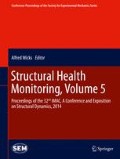Abstract
The Modal Assurance Criterion (MAC) is currently the most popular method for measuring whether or not two mode shapes are strongly correlated. In fact, MAC can be applied to any two sets of data that can be defined as a shape, e.g. mode shapes, Operating Deflection Shapes (ODS’s), or two time or frequency domain waveforms. When applied to two Frequency Response Functions (FRFs) MAC has been renamed FRAC (Allemang RJ, The modal assurance criterion (MAC): twenty years of use and abuse. In: Proceedings of the international modal analysis conference, 2002).
MAC values range between 0 and 1. If MAC = 1, the two shapes are identical. A “rule of thumb” is that two shapes are similar or strongly correlated if MAC > 0.9, and they are different or weakly correlated if MAC < 0.9.
MAC is a measure of the co - linearity of two shapes. That is, it measures whether or not two shapes lie together on the same straight line. MAC has two limitations however;
-
1.
MAC does not measure the difference in values of two shapes.
-
2.
MAC requires at least two shape components. The MAC value for two shapes with one component, i.e. two scalars, is always 1.
In this paper, a new measure, called the Shape Difference Indicator (SDI), is introduced which overcomes the two limitations of MAC. This new measure is more useful for machinery and structural health monitoring applications where, for instance, changes in vibration levels or temperatures are typically used to detect a fault.
An example is given showing how SDI indicates that shape pairs are different even when their MAC values indicate that they are the same, i.e. they are co-linear. A second example shows how SDI can be used not only to detect a fault, but also to correctly identify the fault by comparing its shape values with those in a database of known fault conditions.
Access this chapter
Tax calculation will be finalised at checkout
Purchases are for personal use only
References
Richardson SC, Richardson MH (2008) Using photo modeling to obtain the modes of a structure. In: Proceedings of the international modal analysis conference
Allemang RJ, Brown DL (1982) A correlation coefficient for modal vector analysis. In: Proceedings of the international modal analysis conference
Schwarz BJ, Richardson MH (2014) Linear superposition and modal participation. In: Proceedings of the 32nd international modal analysis conference, Orlando
Allemang RJ (2002) The modal assurance criterion (MAC): twenty years of use and abuse. In: Proceedings of the international modal analysis conference
Author information
Authors and Affiliations
Corresponding author
Editor information
Editors and Affiliations
Rights and permissions
Copyright information
© 2014 The Society for Experimental Mechanics, Inc.
About this paper
Cite this paper
Richardson, S., Tyler, J., McHargue, P., Richardson, M. (2014). A New Measure of Shape Difference. In: Wicks, A. (eds) Structural Health Monitoring, Volume 5. Conference Proceedings of the Society for Experimental Mechanics Series. Springer, Cham. https://doi.org/10.1007/978-3-319-04570-2_8
Download citation
DOI: https://doi.org/10.1007/978-3-319-04570-2_8
Published:
Publisher Name: Springer, Cham
Print ISBN: 978-3-319-04569-6
Online ISBN: 978-3-319-04570-2
eBook Packages: EngineeringEngineering (R0)

